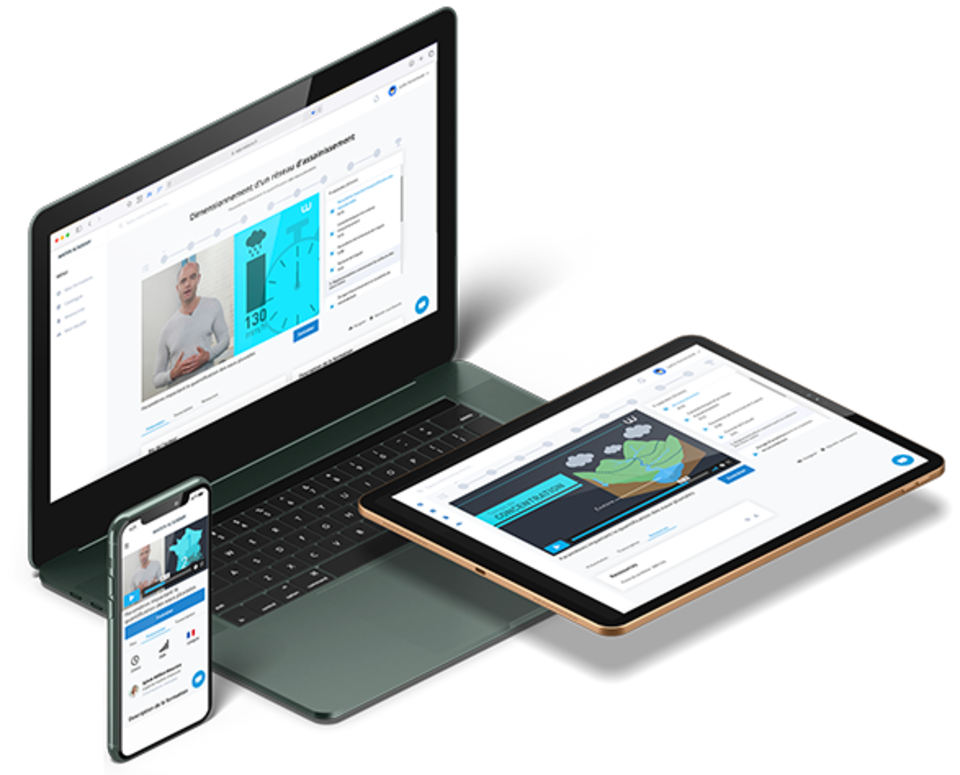In technical sectors, the use of digital tools is typically limited to managers. Consequently, there is a common misconception that online training is challenging for employees who are not familiar with these tools.
Here are 6 tips for effectively implementing your online training strategy.
N°1: Try out the training course with colleagues who are already familiar with digital tools

As the saying has it “Rome was not built in a day” and the same goes for setting up online training courses for your team members.
To ensure it’s a success, it is best to start small. You could, for example, organise a trial session with a small group of employees. The key lies in the careful selection of participants. Avoid having a group of excessively enthusiastic people, as it could result in the emergence of overly sceptical individuals later on.
Similarly, for better results, feel free to involve people with mixed abilities. From a pedagogical perspective, a heterogeneous group learns better than a homogeneous group.
It is the magic of peer learning!
N°2: Adopt the best strategy based on your employees' needs
Your group is ready, now all you have to do is get them involved in the project for the foreseeable future! There’s no secret to this: your employees will tell you more than we can.
To build a coherent strategy, the first step is to listen to the future beneficiaries and analyse their different habits:
-
-
- What methods do they use to develop their knowledge and learn new skills?
- What is their typical day like? Do they sometimes have downtime during the day?
- In what areas do they need to improve their knowledge?
- What kind of educational resources do they prefer?
- How many times a day/week/month do they have access to a computer?
-
Based on this information, you can create different learner profiles, with different needs and abilities (nomadic/sedentary, independent learner/learner needing guidance, etc.).
Once this has been done, it is important to explain to your employees which courses have been selected for them and why.
N°3: Setting up a framework and involving the management team
Once the different learner profiles have been identified, a framework can be set up. For team members that are frequently out in the field, it is recommended to set specific time slots for training, either individually or in small groups (2 or 3 people maximum).
Make sure you schedule these sessions frequently and, if possible, always at the same time: Tuesdays before or after lunch, Friday mornings before starting work etc.
Your aim is to create a routine. Of course, unforeseen emergencies may occasionally prevent a session from taking place. In such instances, promptly reschedule the session.
Finally, it is recommended to schedule sessions well in advance. Write them down in the shared calendar or display them in the staff room. You can also put out a reminder of each session at your staff meetings, for example.
N°4: Provide the right equipment

We sometimes tend to forget about logistics, yet it is an essential piece of the puzzle! As well as the computer, tablet or smartphone that your employees will need for the training course, also consider:
- Having a quiet room/office where you can get some privacy
- Checking your firewalls with your IT department before the first session
- Providing headphones
A 30-minute training session is enough to make noticeable progress. During this time, your employees won’t need their phones! Kindly ask them to put them on “Do not disturb” mode or to put them aside.
N°5: Set clear targets and monitor results for online training

The use of digital technology allows you to accurately assess your employees’ progress. To ensure that the project is successful, you need to set targets:
- How much time should be dedicated to training per week/month/year
- How many training courses should be validated?
- Which training courses are compulsory, and for who?
Optimise your strategy by considering both success indicators (the number of validated training courses) and time indicators (the time spent on the platform).
Make sure you set personalised, measurable, acceptable, realistic targets.
Finally, for a target to be met, it must be shared and acknowledged by everyone involved.
Make them as simple as possible and communicate them regularly to your team members.
N°6: Valuing in-house experience
Your employees will appreciate it if you give them the chance to talk about the advantages and disadvantages of the digital tool they are using. This is the best way to improve the use of this tool and to convince other participants.
Share positive outcomes with your team and recognise each individual’s effort. Grant personalised rewards to highlight their contributions.
In technical professions, the use of digital technology is becoming increasingly accessible to a large number of people, but there must be support along the way. Online training is an excellent way of doing this. It allows you to perfect your core skills while approaching digital technology from a different angle.
To ensure the success of this new online training approach, it is vital to communicate effectively with your team, engaging in attentive listening and recognising their needs.
By Célia Bellange and Mathilde Chagué





